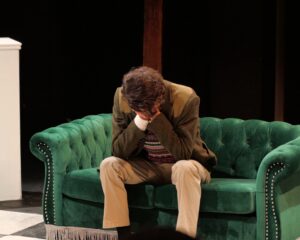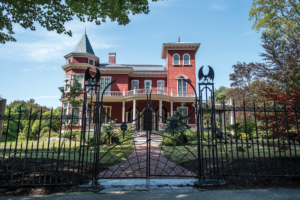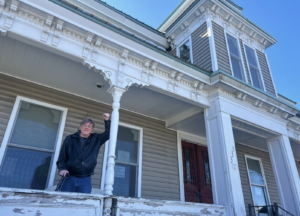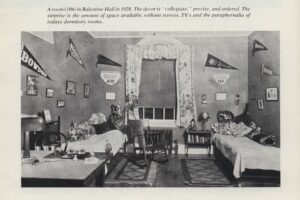
A contradance is a folk dance, where parallel lines of dancers stand opposite, or “contra to” their partners. Brought to North America during the colonial settlement, contradances incorporate elements of English, Irish, Scottish and French folk dance. Since the 17th century, this dance has been passed on from generation to generation as part of American cultural heritage.
Contradances can be found all over the world and in all 50 U.S. states, but it is especially prominent in New England. In fact, contradance is sometimes described as New England folk dance.
On every second Saturday of the month, the Keith Anderson Community Center in downtown Orono holds a contradance. On Saturday, Feb.13, more than 40 members of the community and University of Maine students attended the Valentine’s Day-themed Contradance.
Since 1980, contradance band Marsh Island Band has been playing live music at the Orono contradances. The band members retired two years ago. However, the torch has been passed on to Orono Contraband, a three-piece dance band featuring Anthony Visseli on guitar, Sam Furth on guitar and Ryu Mitsuhashi on fiddle.
Mitsuhashi, a concertmaster for the UMaine Orchestra, is completing her graduate degree in music performance at UMaine. She performed with the Bangor Symphony Orchestra last Saturday, and therefore was unable to play at the contradance.
“I wish I had two bodies and could do both,” Mitshuashi shared.
Mitsuhashi started playing violin when she was 3 years old.
“I grew up playing classical music, and at one point I hated it; but then I heard some tango and gypsy music, and I didn’t think you could play this type of music on violin,” Mitshuashi shared.
Mitsuhashi first encountered fiddle music six years ago, when she attended her first Orono contradance ran by the Marsh Island Band. Mitshuashi was asked by Visseli to fill in for a fiddler who became sick.
“At first I didn’t think I could do it. But at the same time, I was definitely excited and happy to play something other than classical music,” Mitshuashi recalled. “When you play fiddle music, no one judges you if you play the wrong note or the wrong rhythm. As long as the tune is recognizable and danceable, you have the freedom to improvise.”
After her first experience of improvising on violin, Mitshuashi, then an undergraduate music performance student at UMaine, added jazz classes to her curriculum and eventually graduated with a minor in jazz studies.
“I grew up with a violin,” Mitshashi said. “I can’t think of my life not playing violin. However, there were many times when I wanted to quit. So when I found out about different genres, I revived my appreciation towards that instrument. Playing fiddle music for the first time made me re-realize how awesome music is. It gives me joy.”
Last Saturday, Visseli filled in for Mitshuashi on fiddle, while his father substituted for Visseli on mandolin. Despite Orono Contraband being a three-member band, different musicians bring in the tunes of banjo, percussion and bass to the contradance.
“I love the nomadic style of our band,” Mitshuashi shared. “The group is very open and flexible,” she added.
Not only does the band integrate various instruments into the contradance, but it also incorporates various genres of music, such as bluegrass, folk, jazz and even pop.
“If we put limitations to the music, the audience gets limited to,” Mitsuhashi said.
Ron Staples, 68, seems to agree.
“As long as the tune has 68 beats, you can dance to a Grateful Dead song,” he shared. Staples has been attending the Orono contradance with his wife for nearly 15 years.
“I started doing this [contradance] as an exercise, but now it has become a social thing for me and my wife,” Staples said. “I love seeing people of all ages smiling and having fun.”
Staples usually gets to the dance early and teaches the steps to the first-comers. He shared that during his first few contradances, he would only dance one set and rest another. Now, he can dance up to five dances in a row.
“Even with my bad knees, I overlook the pain because of the joy of dancing, honestly. If I think I ought to rest this dance, I say ‘carpe diem’,” Staples said, referencing the Latin phrase for “seize the day.” “This is the only chance I get to dance until the next contradance,” he added.
Staples also attends contradances during his travels across the country.
“When I visit Florida I go to a contradance there, and the only difference is that the rooms are air-conditioned. The music and dances are identical, because they go back to when this country was founded,” Staples said.
Every contradance is led by a caller, a person who teaches the dance before the music starts. At 7.30 p.m. there is a beginner’s session, and at 8 p.m., the atmosphere comes alive as the music starts playing.
“Contradance makes us part of a living tradition,” Pam Weeks, caller of last Saturday’s contradance, said. “We are coming together as a community and creating something beautiful.”
“When we took over the dance, the attendance was very small and had trouble conveying,” Visseli shared. “We said, ‘How can we fix this?’ So we reached out to the Student Government.”
Until last year, UMaine students used to be charged a fee to attend the Orono contradance. Now, with the support from Student Government, the event is free for UMaine students, and $8 for all others. In addition to that, attendees can get $1 off drinks at Woodman’s Bar and Grill — conveniently next door — with a hand stamp.
The next contradance is coming up on Saturday, March 12, while another contradance in the area is held on every third Friday of the month at the Unitarian Universalist Society of Bangor.











